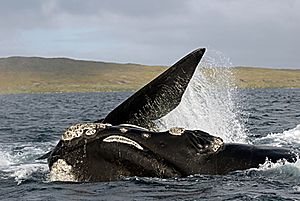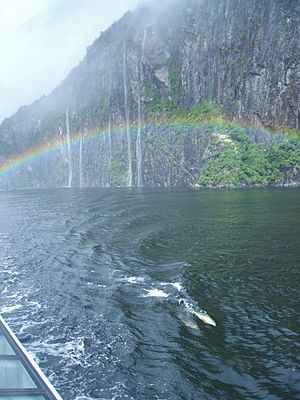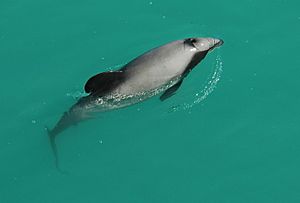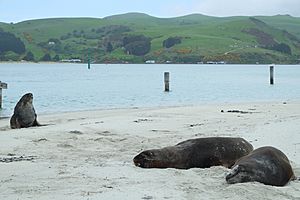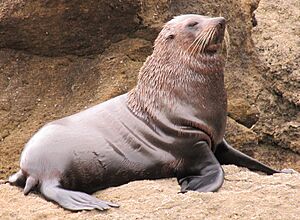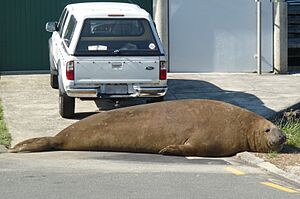List of mammals of New Zealand facts for kids
New Zealand is home to many unique animals! This page lists the native mammals that live here naturally. It doesn't include animals brought by people or very old extinct species. New Zealand has about 51 native mammal species. Sadly, some are in danger: three are critically endangered, three are endangered, three are vulnerable, and one is near threatened.
Scientists use special tags to show how safe or endangered a species is. These tags come from the International Union for Conservation of Nature:
- Critically endangered: This means the species is very, very close to disappearing forever in the wild.
- Endangered: The species faces a very high risk of becoming extinct in the wild.
- Vulnerable: The species is at a high risk of extinction in the wild.
- Near threatened: This species isn't in immediate danger, but it might be in the future.
- Least concern: There are no big risks to this species right now.
- Data deficient: We don't have enough information to know if this species is at risk.
Contents
Bats: Amazing Flying Mammals
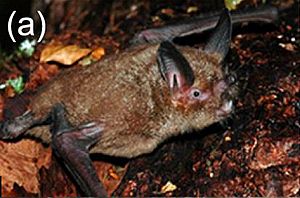
Bats are super cool because they are the only mammals that can truly fly! Their front limbs have turned into wings. About 20% of all mammal species in the world are bats. New Zealand has three special native bat species.
- Short-tailed Bats
- The New Zealand greater short-tailed bat, M. robusta, might be extinct.
- The New Zealand lesser short-tailed bat, M. tuberculata, is still found here.
- Long-tailed Bats
- The New Zealand long-tailed bat, Chalinolobus tuberculatus, is another unique New Zealand bat.
Whales and Dolphins: Ocean Giants
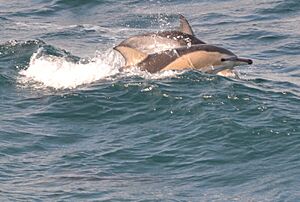


Whales, dolphins, and porpoises are called Cetacea. They are mammals that live completely in the water. They have smooth, nearly hairless bodies and a thick layer of fat called blubber. Their front fins and tail help them swim fast underwater. New Zealand was the first country to protect marine mammals by law!
Here are some of the amazing cetaceans you might find in New Zealand waters:
- Baleen Whales (Mysticeti)
- Southern right whale, Eubalaena australis
- Southern minke whale, Balaenoptera bonaerensis
- Bryde's whale, Balaenoptera edeni
- Blue whale, Balaenoptera musculus
- Humpback whale, Megaptera novaeangliae
- Pygmy right whale, Caperea marginata
- Toothed Whales and Dolphins (Odontoceti)
- Sperm whale, Physeter macrocephalus
- Pygmy sperm whale, Kogia breviceps
- Dwarf sperm whale, Kogia sima
- Cuvier's beaked whale, Ziphius cavirostris
- Hector's dolphin, Cephalorhynchus hectori
- Maui's dolphin, Cephalorhynchus hectori maui (a subspecies of Hector's dolphin, very rare!)
- Common bottlenose dolphin, Tursiops truncatus
- Long-beaked common dolphin, Delphinus capensis
- Short-beaked common dolphin, Delphinus delphis
- Dusky dolphin, Lagenorhynchus obscurus
- Orca (also known as Killer whale), Orcinus orca
- Long-finned pilot whale, Globicephala melas
Seals and Sea Lions: Ocean Carnivores
Carnivorans are animals that mostly eat meat. They have special teeth and skull shapes for this. In New Zealand, all seven native carnivoran species are pinnipeds, which means they are seals or sea lions.
- Eared Seals and Sea Lions
- New Zealand fur seal, A. forsteri
- New Zealand sea lion, P. hookeri
- Earless Seals
- Leopard seal, H. leptonyx
- Southern elephant seal, M. leonina
See also
- Fauna of New Zealand
- Mammals of New Zealand
- Pacific Islands Cetaceans Memorandum of Understanding


